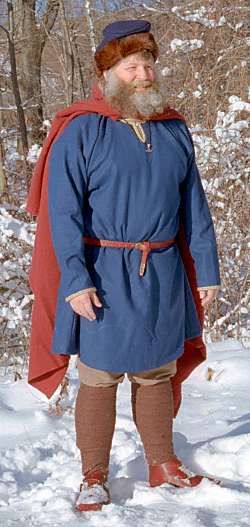Genius Hour is coming to a close; though, I love getting good grades for the things I'm actually interested in (with a passion might I add) I will attempt to continue this blog until I eventually grow tired of the Nordic way of life. These past few weeks went by so quickly I still remember my very post and how nervous I was to show the world my love for the Vikings. Since this will be my last post for a grade my teacher has asked me to answer a few questions within this post. These questions include:
1. What was your favorite part of the topic you chose?
2. What was your least favorite part of the topic you chose?
3. What do you like best about Genius Hour research?
4. What do you like least about Genius Hour research?
5. What was the most important thing you learned about yourself, how you learn, or research in general as a result of this work?
Throughout my research and writing time I would have to say learning about their cuisine was my favorite part. Considering how long ago they lived I was shocked at how much they had documented and how diverse they were! With a long journey, there is destined to be rough patches in the road, within my highway of a journey I had to attempt to find which language they spoke. They were so diverse that some people spoke a different language. I did however, find that most of them spoke Old Norse. Which is similar to Old English, this isn't the term for the way Shakespeare spoke either!
If I had to choose a favorite part about my research I would have to pick being able to take time out of my regular boring day to learn more about people I have a passion for. Weird, right? My least favorite part was having to avoid all the confusion the computer had between the Minnesota Vikings and the Nordic people I was researching... As a result of this work, I feel I have learned a lot of myself and how I always strive for the knowledge of things school drives me away from. Also, I often feel uncomfortable in those hard chairs in our computer lab just staring up at a screen with a lot of noise from others. Meaning I did and didn't get much done during school hours (sorry Mrs H). I did make up for it in the comfort and solitude of my bedroom, though. I've learned that I as a researcher need to take more thorough notes because when I look back on them I tend to forget what I meant when I abbreviate.
I wish to hear from you in the comments over what you've thought of my past blog entries! hopefully you'll continue this journey with me (even if you get super bored and this is the only thing you can do for "entertainment") thank you to those who have read and have decided not to continue with me. Have a nice week everyone! :)
Saturday, May 9, 2015
Sunday, May 3, 2015
Weaponry
Vikings weren't just masters of thievery, food, and making textiles. They were also masters at weaponry! Of course in order to raid towns and other ships they needed weapons to dominate Scandinavia. The main three types of weapons used were swords, spears and axes. Spears seemed to be of the most common weapon used seeing as it was the cheapest weapon around. A less common weapon used was the bow and arrow.
Viking shields were often 34-36" in diameter and were .5" thick. They had planks of dry wood butted together. The wood they used was mainly spruce, fir and pine since these woods were considered lightweight and they didn't split easily. At the center of a shield was a domed iron boss.
The nails holding the boss in place also held a hand grip for the owner to grip and move the shield freely. the hand grip was often also made of wood; though, some have been found to have been made with iron as well. The rim of the shield was often lined with leather or rawhide to keep it from splitting at the edges. Fronts of shields were also sometimes lined in leather because it was most resistant to weapons.
These are just the more common weapons the Vikings used. Of course they used more weapons made of different materials. Next week I plan on covering either Old Norse, their language, or Norse Mythology. Have a great week! Góðan daginn!
Every free man was expected to own a weapon. Axes were often found lying around the houses of the Vikings seeing as it was and still is a common farm house item. Swords are the most common to find while digging through burial mounts. Though, in order for the vikings to produce the swords, the status of the sword owner had to be very high because it was very expensive to make them.
 |
| Viking swords from Burial Mount |
Considering Vikings fought on foot and in a loose formation, they had to have light loose armor that protected the wearer individually. The horned helmets weren't actually big and heavy as most would think! they were very light, uncommon and very few had the runes of their tribe and face covers. The Vikings did, however, have decorative shields to carry with them. The shield themselves are not complicated to replicate; though, the designs are.
 |
| Refurbished Viking Shields |
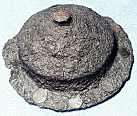 |
| shield boss |
These are just the more common weapons the Vikings used. Of course they used more weapons made of different materials. Next week I plan on covering either Old Norse, their language, or Norse Mythology. Have a great week! Góðan daginn!
Sunday, April 26, 2015
Viking Cuisine
Vikings were people of large size. With such a large size they had to eat a lot of food. The food they ate varied with their location. I have compiled a list of foods or ingredients that most all the tribes ate collectively.
Mammals: cattle, pigs, sheep, goat, oxen
Fish: cod, herring, ling
Birds: duck, chicken, goose, plover, cormorant
Cereals: oats, flax, spelt, hemp, rye, wheat, barley
Fruit: apple, blackberry,"stone fruits" (plums, slomes, damsons), strawberry, sloe, elderberry, mountain ash, rose hips, cloudberries, crabapple, juniper berries
Nuts: hazelnut walnut
Veggies: celery, carrots, turnips, swede, radish, fennel, brassicas, nettle, cress
Legumes: peas, beans
Barley was in almost every meal. Whether if it was Barley cakes, Barley and Fish or Meat and Berries, Barley was a main component. In my last post, some of you wanted me to make a Viking dish. I have decided to make Barley cakes considering desserts are my specialty in the kitchen. I'll leave the recipe at the end of the post for those who want to try it!
In order for Vikings to eat, they had to have some utensils to help them make and eat without just their hands. The utensils that have been found are pots, pans, forks, knives, spoons, kettles, strainers, metal pots and or cauldrons. They have also found wooden bowls and wooden plates. A more uncommon utensil that has been found is a large metal fork for cooking food directly above fire. Chains and tripods for hanging pots have also been found. Like the modern gridiron for making pancakes and bacon have been dug up!
For the sick and cold winter nights, Vikings used wooden, soapstone, or metal bowls for soup.
Curd draining boards, butter churns, wooden sieves with the nalbinding technique from horse hair and their version of the "sippy cup" have been found. Who knew the Vikings could be this advanced? Many would still say they were savages from their thievery but from that sippy cup they found they were pretty docile people.
Barley Cakes:
-ingredients
2 cups barley flour
water or milk to make thin batter
2-3 eggs
pinch of salt
Fish: cod, herring, ling
Birds: duck, chicken, goose, plover, cormorant
Cereals: oats, flax, spelt, hemp, rye, wheat, barley
Fruit: apple, blackberry,"stone fruits" (plums, slomes, damsons), strawberry, sloe, elderberry, mountain ash, rose hips, cloudberries, crabapple, juniper berries
Nuts: hazelnut walnut
Veggies: celery, carrots, turnips, swede, radish, fennel, brassicas, nettle, cress
Legumes: peas, beans
Barley was in almost every meal. Whether if it was Barley cakes, Barley and Fish or Meat and Berries, Barley was a main component. In my last post, some of you wanted me to make a Viking dish. I have decided to make Barley cakes considering desserts are my specialty in the kitchen. I'll leave the recipe at the end of the post for those who want to try it!
In order for Vikings to eat, they had to have some utensils to help them make and eat without just their hands. The utensils that have been found are pots, pans, forks, knives, spoons, kettles, strainers, metal pots and or cauldrons. They have also found wooden bowls and wooden plates. A more uncommon utensil that has been found is a large metal fork for cooking food directly above fire. Chains and tripods for hanging pots have also been found. Like the modern gridiron for making pancakes and bacon have been dug up!
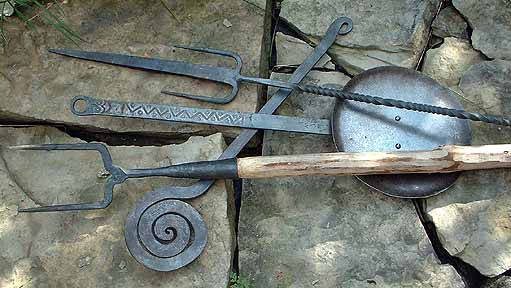 |
| Utensils used for cooking over a fire. |
Curd draining boards, butter churns, wooden sieves with the nalbinding technique from horse hair and their version of the "sippy cup" have been found. Who knew the Vikings could be this advanced? Many would still say they were savages from their thievery but from that sippy cup they found they were pretty docile people.
 |
| Viking spoons. |
Barley Cakes:
-ingredients
2 cups barley flour
water or milk to make thin batter
2-3 eggs
pinch of salt
Preparation:
Mix everything into a thin batter.
Cook like pancakes on griddle or frying pan.
Optionals: You can leave the eggs out but they would cook a bit better with them in.
Serve: You may add butter and honey or any sweet syrup of your choice. You may also serve them with smoked or pickled fish, roast chicken, any other meats and fruit.
Enjoy!
Mix everything into a thin batter.
Cook like pancakes on griddle or frying pan.
Optionals: You can leave the eggs out but they would cook a bit better with them in.
Serve: You may add butter and honey or any sweet syrup of your choice. You may also serve them with smoked or pickled fish, roast chicken, any other meats and fruit.
Enjoy!
Tuesday, April 14, 2015
Who Were the Vikings?
The term Viking is a general name to describe the people of Scandinavia from the ninth to eleventh centuries. As if, we called the French or the Spanish Pirates. A name for profession. The Scandinavians were people made up of farmers, explorers -hunters-, fishermen, and merchants. Vikings were mainly men. As seamen and warriors, they chose this way of life to prove themselves men. They mainly raided neighboring kingdoms and churches nearby.
Vikings were masters of the sea. They traveled on Dragon boats. The name of these boats is fairly self explanatory. Though, as their raids became more and more frequent they became greedy people. The raids soon turned into a tradition and they had many boys and men lining up to join the raids. When they would go on raids they often searched and took livestock, coins, weapons, thralls, treasures, spices, works of art and raw materials. Though, they didn't actually want these things that they stole. They felt obligated with their power to take these things, anyway.
As many associate with them, their horned helmets weren't actually apart of their "armor"! They saw it as extra weight to what they were already carrying. Their clothing was mainly hand made and woven by the women of their settlements. Men typically wore tunics that were tight fitting at the chest but had a broad skirt. They also wore either tight or loose trousers depending on the occasion and season. In addition to the tunic and trousers they wore a cloak to keep warm. The outer layer of a man's tunic was called a kyrtill, often made of wool and made with complicated patterns. The style of tunics and under tunics were limited, trousers however, varied very much, from fabric to stitching. Some were tight, others baggy. Some had built in socks, others had heel straps. All in all, Vikings trousers had no fly and no pockets. Meaning both men and women had to find other ways to carry their belonging with them. Many Vikings wore puttee leg wraps to gather excess fabric by the ankles.
Women typically wore clothing made with the same fabric as men but the clothing was ankle length. The neck was closed by a brooch. Over that dress she would wear a shorter woolen dress suspended by straps and intricate metallic brooches, this type of overdress was called a hangerock. Though, these also varied in size and shape.
Beads made of glass or ember were often strung in between the brooches. Women also carried everyday items with them suspended from their belts, brooches, or pouches. These everyday items consisted of keys, scissors, needles, a knife, whetstone and much more depending on the woman. Some women wore shawls, cloaks and coat-like covers. Shawls and cloaks were much more common and often fastened with a tri-lobed brooch.
Vikings were masters of the sea. They traveled on Dragon boats. The name of these boats is fairly self explanatory. Though, as their raids became more and more frequent they became greedy people. The raids soon turned into a tradition and they had many boys and men lining up to join the raids. When they would go on raids they often searched and took livestock, coins, weapons, thralls, treasures, spices, works of art and raw materials. Though, they didn't actually want these things that they stole. They felt obligated with their power to take these things, anyway.
| Viking Dragon Boat |
As many associate with them, their horned helmets weren't actually apart of their "armor"! They saw it as extra weight to what they were already carrying. Their clothing was mainly hand made and woven by the women of their settlements. Men typically wore tunics that were tight fitting at the chest but had a broad skirt. They also wore either tight or loose trousers depending on the occasion and season. In addition to the tunic and trousers they wore a cloak to keep warm. The outer layer of a man's tunic was called a kyrtill, often made of wool and made with complicated patterns. The style of tunics and under tunics were limited, trousers however, varied very much, from fabric to stitching. Some were tight, others baggy. Some had built in socks, others had heel straps. All in all, Vikings trousers had no fly and no pockets. Meaning both men and women had to find other ways to carry their belonging with them. Many Vikings wore puttee leg wraps to gather excess fabric by the ankles.
Women typically wore clothing made with the same fabric as men but the clothing was ankle length. The neck was closed by a brooch. Over that dress she would wear a shorter woolen dress suspended by straps and intricate metallic brooches, this type of overdress was called a hangerock. Though, these also varied in size and shape.
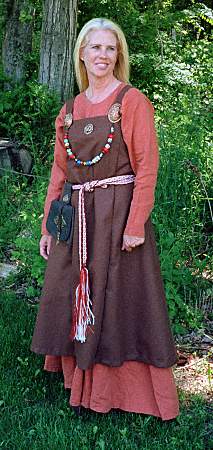 |
| Description above |
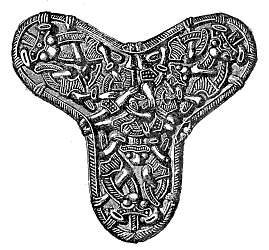 |
| Tri-lobed brooch |
Of course the Vikings had much more to who they were including language, cuisine, weaponry and traditions. Next week, I will explore the Viking cuisine. This week was as informative as any other! Please leave your thoughts in the comments and I hope you read my next update on "Viking Cuisine"!
Wednesday, April 8, 2015
How Much Can I Learn About Vikings in Seven Weeks?
I chose to research the life of the Vikings because their way of life fascinates me. Within my seven week journey I plan to learn about their weaponry, cuisine-if they had one-, mythology and their day-to-day routines!
Though, with every journey come potholes and road blocks. When I reach those bumpy paths I will ask myself more questions about why they haven't found that information, why the Vikings did such and how I can get past all the football posts. Because the Vikings seem like mythical creatures, I plan to figure out if their mythology isn't truly a myth. There have been many movies, both foreign and American, on Norse mythology. Within their mythology are many creatures they believed to be real that I want to find out if they were real.
For the next seven weeks I will be researching and slowly perfecting my Viking expertise. I hope not to lose interest in something I currently love and hope to help you fall in love with wonderful people from the eleventh-century!
Subscribe to:
Comments (Atom)
